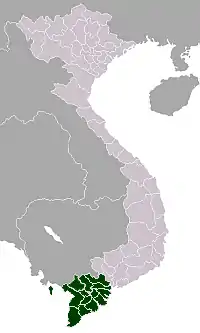List of active separatist movements in Asia
This is a list of active separatist movements in Asia. Separatism can include autonomism and secessionism,[1] although independence is the main goal of many separatist movements. Many separatist movements come about from religious, ethnic, social, and cultural differences between certain peoples and those of the majority or ruling class within a region. What is and is not considered an autonomist or secessionist movement is sometimes contentious; entries included on this list must be recognized by reliable sources as active, separatist, and made up of members of the country from which independence is sought.
Under each region listed is one or more of the following:
- De facto/proposed state and/or autonomous area: proposed name for a seceding or anticipated sovereign state, or area in which more autonomy is sought.
- Supporting organizations: Advocacy, ethnic, ethno-religious, political, racial, regional, and/or religious group(s) which take a major part in separatism for the movement.
- Government-in-exile: for a government based outside of the region in question, with or without control.
- Leader(s): Known individuals who maintain major positions within the separatist movement or organization(s)
For movements which maintain a de facto state or control areas of land, militant organization(s) are listed as well.
Azerbaijan
- Ethnic group: Armenians
- De facto state: Republic of Artsakh
- Ethnic Azerbaijani organization in exile: Azerbaijani Community of Nagorno-Karabakh
- Ethnic group: Lezgins
- Proposed state: Lezgistan
- Ethnic group: Talysh people[2][3]
- Proposed state: Talysh-Mughan Autonomous Republic
- Political party: The National Talysh Movement
 Location of Nagorno-Karabakh
Location of Nagorno-Karabakh The current borders of the self-proclaimed Republic of Artsakh after the 2020 Nagorno-Karabakh War
The current borders of the self-proclaimed Republic of Artsakh after the 2020 Nagorno-Karabakh War The area of Lezgin settlement in the border of Russia and Azerbaijan
The area of Lezgin settlement in the border of Russia and Azerbaijan
China
 Taiwan is not included in this list because it has never been governed by the People's Republic of China.
Taiwan is not included in this list because it has never been governed by the People's Republic of China. The Tibetan independence movement can either encompass the smaller Tibetan Autonomous Region (Xizang) or the larger "Greater Tibet".
The Tibetan independence movement can either encompass the smaller Tibetan Autonomous Region (Xizang) or the larger "Greater Tibet".
| Significant Secessionist Movements in China | ||||||
| No. | Claimed Territory | Capital City | Area (km2) | Population (~) | Ethnic Group | Primary Independence Movement |
|---|---|---|---|---|---|---|
| 1 | Ürümqi | 1,828,418 | 25,000,000 | Uyghur people | East Turkestan independence movement | |
| 2 | Lhasa | 2,500,000 | 3,200,000 | Tibetan people | Tibetan independence movement | |
| 3 | Hohhot | 1,183,000 | 25,000,000 | Chinese Mongols | Inner Mongolian independence movement | |
| 4 | Hong Kong | 2,755 | 7,500,000 | Hong Kong people | Hong Kong independence movement | |
| 5 | Macau | 115 | 700,000 | Macau people | Macau independence movement | |
Many current separatist movements in China arise from the country's ethnic issues. Some of the forces that have created these ethnic issues include history, nationalism, economic and political disparity, religion, and other factors. China has historically had tensions between the majority Han and other ethnic groups, particularly in rural and border regions. Historically other ruling ethnicities, such as the Manchu of the early-Qing dynasty, experienced racial issues as well.[7] Ethnic tensions have led to incidents in the country such as the July 2009 Ürümqi riots.
During the Qing dynasty, European powers (and Japan) acquired treaty ports and concessions within cities in China through unequal treaties. Most of these were returned to China during the early-to-mid 20th century, although Hong Kong and Macau were both colonies of the United Kingdom and Portugal respectively until the 1990s. Following their return to China, both were organized as special administrative regions with a degree of autonomy in their administrations. However, according to present agreements both regions will be fully integrated into China in the late-2040s.[8] The future loss of autonomy has caused the growth of separatist movements particularly in Hong Kong, as could be seen during the 2019-20 Hong Kong protests.
Despite being a special administrative region, Macau has few substantial active independence or separatist movements unlike Hong Kong.[9] This is usually attributed to Macau's reliance on tourism from mainland China, extremely high per capita GDP, and a historical support of unification with China, such as that surrounding the 12-3 incident.[10][11]
Taiwan is not included in this list because it is not governed by the People's Republic of China. Taiwan is fully recognized by 15 members of the United Nations with others maintaining unofficial relations.[12]

- Ethnic group: Hong Kongers and Cantonese people,[13] sometimes Taiwanese people, Chinese people, and foreigners in Hong Kong[14]
Hong Kong independence movement:
- Proposed goals: Hong Kong Independence, separation from China[15]
- Supporting organizations: Independence-leaning localist groups including Hong Kong Independence Party, Youngspiration
- Leaders: Daniel Ma (HKIP), Baggio Leung (Youngspiration)
- Proposed goals: Universal suffrage in the election of Chief Executive,[16] increased autonomy in general, self-determination[17]
- Supporting organizations: Civil Human Rights Front, localist groups, various informal protest and activist groups
- Leaders: Figo Chan (CHRF), former Demosistō leaders include Joshua Wong and Agnes Chow
In 1997 the colony of Hong Kong was retroceded to China, leading to the creation of the Hong Kong Special Administrative Region. Under the jointly agreed upon Hong Kong Basic Law, the Hong Kong SAR would maintain its autonomy for 50 years until 2047,[8] after which point the region would assume full control by China. Hong Kong's autonomy, and its end in 2047, has created contention between those who support the Chinese government, and those who do not.[18] A particular source of contention in recent years is with the structure of the Hong Kong government, where the Chief Executive is appointed by the Chinese government while local elections are held directly.[19]
In 2019 the Hong Kong extradition bill was proposed, which sparked protests throughout Hong Kong.[20] During the protests which followed, the pro-democracy camp gained general support alongside the Hong Kong independence movement to a small extent as well. Many of the anti-governmental groups supported localism and universal suffrage in all Hong Kong elections. In May 2020 the National People's Congress of China passed a decision concerning Hong Kong national security legislation, whereby "secession" and "subversion" were made illegal. This move has meant that pro-independence calls are now illegal by the new decision, although some still do call for independence despite the changes to the law.[15] In Hong Kong, the pro-democracy camp enjoys general support, though the passing of the decision by the NPC has made protesting and the organization of protests more difficult.[21]
Inner Mongolia (South Mongolia; Nei Menggu)
- Ethnic group: Chinese Mongols, Mongols
- Proposed goals: Inner Mongolian independence, unification with Mongolia
- Supporting organizations: Inner Mongolian People's Party (member of the Unrepresented Nations and Peoples Organization)
- Leader: Temtsiltu Shobtsood
Inner Mongolia (also known as Southern Mongolia or Nei Menggu from Chinese) is a member of the Unrepresented Nations and Peoples Organization,[22] with pro-independence protests and separatism having been particularly prevalent in the early-2010s.[23] Despite Inner Mongolia being a member of the UNPO, the news agency Quartz describes Inner Mongolian separatism in 2020 as "non-existent".[24] The Chinese government asserts however that there is currently Inner Mongolian separatism resulting from the 2020 Inner Mongolia protests, although few specific examples have been noted.[25] In 2018, Chinese media reported that a man surnamed Jiang was the first in Inner Mongolia to be sentenced on charges of terrorism in the region, although it was not specified what cause he was supporting.[26]
- Ethnic group: Shanghainese people
- Supporting organization: Shanghai National Party
- Leader: He Anquan
According to Radio Free Asia, the Shanghai National Party is a political party founded to support independence for the Shanghai municipality.[27] The group was founded in New York City in 2018 with He Anquan as its leader.[28] The group supposedly does not recognize the unification of China in 256 BCE and takes inspiration from the Hong Kong independence movement. According to some Chinese dissidents the group's goal "isn't realistic".[27]

Tibet (Xizang)
- Ethnic group: Tibetans
- Proposed goals: Tibetan independence, or the creation of a highly autonomous constituent republic of China[29] encompassing the Tibetan AR, Qinghai, and parts of Yunnan and Sichuan
- Supporting organizations: Tibetan Youth Congress
- Government-in-exile: Central Tibetan Administration (member of the Unrepresented Nations and Peoples Organization)
- Major political organizations: National Democratic Party of Tibet
- Leaders: Lobsang Sangay (CTA sikyong), Tenzin Gyatso (14th Dalai Lama)
Tibet was a protectorate controlled by the Qing dynasty from around 1720 until the latter's collapse.[30] In 1911-12 as the Xinhai revolution was occurring, Tibet gained its sovereignty once again.[31] In 1951 after the Communist Party of China won the Chinese civil war, Tibet was annexed by China after a military expedition, which was then affirmed by the Seventeen Point Agreement. With the Dalai Lama and other major figures, the Central Tibetan Administration was formed as a government in exile for Tibet in India in 1959. Within Tibet there have been various calls for autonomy and independence over the years, which the Chinese government has refused.[32] Calls for autonomy and/or independence have manifested through non-confrontational means such as self-immolation, although confrontation has occurred, like that of the Chushi Gangdruk from the 1950s to 1970s.[33]

Xinjiang (East Turkestan)
- Ethnic group: Uyghurs, sometimes other ethnic groups in Xinjiang such as Kazakhs, and occasionally other Turkic peoples
East Turkestan independence movement:
- Proposed goals: Creation of the "East Turkestan Republic" as an independent, secular[34] state encompassing Xinjiang and sometimes parts of Qinghai and Gansu provinces
- Supporting organizations: East Turkistan National Awakening Movement, World Uyghur Congress (member of the Unrepresented Nations and Peoples Organization)
- Government-in-exile (claimed): East Turkistan Government-in-Exile
- Leaders: Salih Hudayar (ETNAM), Dolkun Isa (WUC), Ghulam Osman Yaghma (ETGE)
Turkestan Islamic Party (East Turkestan Islamic Movement):
- Proposed goals: Creation of an Islamic state in Xinjiang, with the broader goal of creating a larger Islamic state and/or caliphate
- Supporting organizations: Turkistan Islamic Party in Syria (sub-organization), Al-Qaeda (allied militarily)[35]
- Militant organization: Turkestan Islamic Party (the TIP is itself a military organization)
- Leader: Abdul Haq al-Turkistani (Memtimin Memet)
Xinjiang has been scene to multiple Uyghur movements and states throughout the years, particularly during the 20th-century with the First East Turkestan Republic and the Soviet-backed Second East Turkestan Republic. In Xinjiang today, some Uyghurs and other ethnicities support the region's independence due to alleged religious, cultural, and social restrictions. The East Turkestan independence movement supports the creation of a secular republic by non-violent means.[36] The World Uyghur Congress represents Xinjiang in the UNPO and is one of the largest groups supporting the region's independence.[37] The Chinese government alleges that all movements supporting independence for Xinjiang are terrorist or separatist groups.[38]
A smaller movement within the region is the Turkestan Islamic Party, whose goal is the creation of an Islamic state through violence and mostly active in China, Syria, and Afghanistan.[39][40] The Turkestan Islamic Party is not part of any international organizations, and is considered a terrorist group by China, the United Kingdom,[41] United Nations,[42] European Union,[40] among others. The United States recognized the TIP as a terrorist group from 2003 until 2020, when it was delisted.[39]
Cyprus

- Breakaway state
- Ethnic group: Turkish Cypriot
- De facto state:
 Turkish Republic of Northern Cyprus
Turkish Republic of Northern Cyprus
- Political organisation: Government of Northern Cyprus
- De facto state:
Georgia
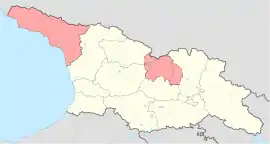
Breakaway states:
- Ethnic group: Abkhaz
- De facto state with partial de jure recognition:
 Republic of Abkhazia
Republic of Abkhazia - Political organisation:Government of Abkhazia
- Militant organization: Abkhazia Army
- De facto state with partial de jure recognition:
- Ethnic group: Ossetians
- De facto state: Republic of South Ossetia, proposed integration to
 Russia
Russia - Political organisation: Government of South Ossetia
- Militant organization: South Ossetia Army
- De facto state: Republic of South Ossetia, proposed integration to
Proposed autonomous movements: Armenians in Javakheti
- Ethnic group: Armenians
- Proposed autonomous area: Javakhk
- Advocacy groups: United Javakhk Democratic Alliance, Virk[43][44]
India



- Proposed state:
.svg.png.webp) Kashmir
Kashmir
- Ethnic group: Kashmiri
- Political organization (Obsolete): All Parties Hurriyat Conference, Jammu Kashmir Liberation Front
- Militant organization:
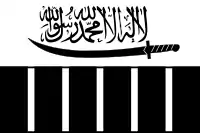 Lashkar-e-Taiba, Hizbul Mujahideen
Lashkar-e-Taiba, Hizbul Mujahideen
- Proposed state: Kamtapur
- Ethnic group: Kamtapuri
- Militant organization:
 Kamtapur Liberation Organisation
Kamtapur Liberation Organisation
- Proposed state: Karbi
- Ethnic group: Karbi
- Militant organization:
 Karbi Longri N.C. Hills Liberation Front
Karbi Longri N.C. Hills Liberation Front
- Proposed state:
 Manipur
Manipur
- Ethnic group: Meitei,Hao,Pangal
- Militant organization:
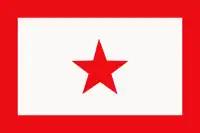 UNLF,
UNLF,  PLA,
PLA,  Kangleipak Communist Party, People's Revolutionary Party of Kangleipak, Kanglei Yawol Kanna Lup,
Kangleipak Communist Party, People's Revolutionary Party of Kangleipak, Kanglei Yawol Kanna Lup,  Maoist Communist Party of Manipur
Maoist Communist Party of Manipur
- Proposed state:
 Nagalim
Nagalim
- Proposed state: Khalistan
- Ethnic-Religious group: Punjabi Sikh.
Indonesia

- Ethnic groups: Acehnese
- Proposed state:
 Republic of Aceh
Republic of Aceh - Militant organisation: Free Aceh Movement (negotiated peace with the Indonesian government in 2005, and now it is a civil movement, but the separatism still has supporters)
- Proposed state:
- Ethnic group: Balinese
- Proposed state:Balinese Republic[48][49]
- Advocacy group: Baduy Society, Bali Fourm, Bali Freedom Movement
- Political party: Dharma Awakening Party
- Ethnic group: Bataks
- Ethnic group: Minahasan
- Proposed state:
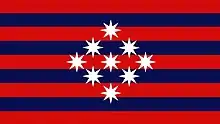 Gerakan Kemerdekaan Minahasa
Gerakan Kemerdekaan Minahasa
- Proposed state:
- Ethnic group: Riau Malays
- Ethnic group: Moluccans
- Proposed state:
 South Moluccas
South Moluccas - Government-in-exile: Republik Maluku Selatan (member of the Unrepresented Nations and Peoples Organization)
- Advocacy group: Maluku Sovereignty Front
- Proposed state:
Iran
- Ethnic group: Arab
- Proposed state: Islamic Republic of Al-Ahwaz[54]

- Militant organisations: Al-Ahwaz Arab People's Democratic Popular Front, National Liberation Movement of Ahwaz, Ahwaz Arab Renaissance Party, Ahwaz Liberation Organisation, Arab Struggle Movement for the Liberation of Ahwaz
- Advocacy group: Democratic Solidarity Party of Al-Ahwaz (member of the Unrepresented Nations and Peoples Organization)
- Proposed state: Islamic Republic of Al-Ahwaz[54]
- Ethnic groups: Kurdish
- Proposed state: Commonwealth of East Kurdistan[55]

- Political parties: Kurdistan Democratic Party of Iran (member of the Unrepresented Nations and Peoples Organization)
- Militant organisations: Party for a Free Life in Kurdistan, Komalah
- Proposed state: Commonwealth of East Kurdistan[55]
Iraq
Proposed state: ![]() Most Serene Republic of Central Kurdistan
Most Serene Republic of Central Kurdistan
- Majority ethnic group: Kurdish
- Current de jure and de facto autonomous region: Iraqi Kurdistan
- Political parties: Kurdistan Independence Movement, Kurdistan Democratic Party of Iraq, Patriotic Union of Kurdistan (members of the Unrepresented Nations and Peoples Organization)
- Military: Peshmerga
Proposed autonomous area: Nineveh Plains
- Ethnic group: Assyrian
- Proposed state:
 Democratic Republic of Assyria
Democratic Republic of Assyria - Political parties: Assyrian Democratic Movement, Assyria Liberation Party
- Militant isations: Nineveh Plain Protection Units, Dwekh Nawsha
- Advocacy groups: Assyrian General Conference, Assyria Council of Europe
- Proposed state:
Proposed autonomous area: Al-Rafidain Autonomous Region
Japan
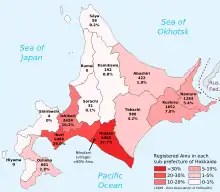

- Ethnic group: Ainu
- Proposed state: Republic of Ainu
- Advocacy group: Ainu Liberation Alliance
- Political parties: Ainu Party (アイヌ民族党, Ainu minzoku tō)
- Political group: Ainu independence movement
- Ethnic group: Ryukyuan
- Proposed state: Republic of Ryukyu[58]
- Political parties: Kariyushi Club (Formerly, Ryukyu Independence Party, 琉球独立党, Ryūkyū Dokuritsutō)
- Political groups: Ryukyu independence movement
- Note: The supporters of the movement want the Amami Islands in Kagoshima Prefecture, former part of the defunct Ryukyu Kingdom until 1609, to be part of independent Ryukyu. See also Invasion of Ryukyu.
Malaysia
.png.webp)
(Red) Federal Territories
|
- Proposed state: Johor[59]
- Ethnic group: Kelantanese
- Proposed state: Kelantan[60]
- Ethnic groups: Melanau, Dayak
- Proposed state: Sarawak
- Advocacy group: Borneo Heritage Foundation (BHF), Sarawak For Sarawakian Big Team (S4S Big Team), Sarawak Association of People's Aspirations (SAPA), Sarawak Sovereignty Movement, Sabah Sarawak Keluar Malaysia (SSKM), Sarawak Liberation Movement[61][65][66]
- Ethnic groups: Kadazan-Dusun, Sama-Bajau
- Proposed state: Sabah
- Advocacy group: Borneo Heritage Foundation (BHF), Sabah Sarawak Keluar Malaysia (SSKM)[61][65]
Myanmar

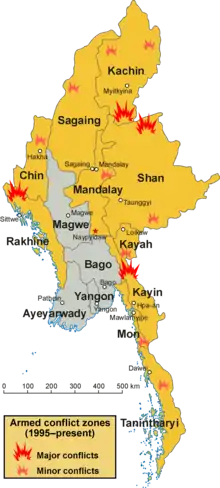

- Ethnic group: Rakhine
- Proposed state:
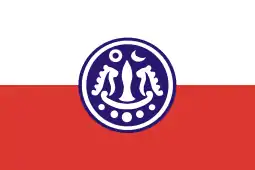 Arakan Federation
Arakan Federation - Advocacy group: Arakan Independence Alliance, Arakan Army (Kachin State), Arakan Army (Kayin State)
- Proposed state:
- Ethnic group: Chin
- Proposed state: Republic of Zo Asia

- Militant organisation: Chin National Front (member of the Unrepresented Nations and Peoples Organization)
- Ethnic group: Kachin
- Proposed state: Kachinland

- Political party: Kachin National Organization
- Proposed state: Kachinland
- Ethnic group: Karen
- Proposed state: Republic of Kawthoolei

- Militant organisation: Karen National Liberation Army
- Advocacy group: Karen National Union
- Proposed state: Republic of Kawthoolei
- Ethnic group: Karenni
- Proposed state: United Karenni Independent States

- Militant organisation: Karenni Army
- Advocacy group: Karenni National Progressive Party (member of the Unrepresented Nations and Peoples Organization)
- Government-in-exile: Karenni Provisional Government
- Proposed state: United Karenni Independent States
- Ethnic group: Kokang people (ethnic Han Chinese)
- Proposed state:
- Militant organisation: Myanmar National Democratic Alliance Army
- Ethnic group: Mon
- Proposed state: Mon Democratic People's Republic
.svg.png.webp)
- Political party: New Mon State Party
- Proposed state: Mon Democratic People's Republic
- Ethnic group: Rohingya
- Proposed state: Rahmanland
.png.webp)
- Militant organisation: Arakan Rohingya Salvation Army[67]
- Advocacy group: Arakan Rohingya National Organisation,[68][69] Rohingya National Council[70]
- Proposed state: Rahmanland
- Ethnic group: Shan (member of the Unrepresented Nations and Peoples Organization)
- Proposed state: Shan Republic

- Political party: Shan Democratic Union
- Militant organisation: Shan State Army
- Advocacy group: Restoration Council of Shan State
- Government in exile: Interim Government of Federated Shan States[71]
- Proposed state: Shan Republic
- Ethnic group: Wa
- Proposed state:

- Political party: United Wa State Party
- Militant organisation: United Wa State Army
- Proposed state:
- Ethnic group: Kuki
- Proposed state: Zale'n-gam

- Militant organisation: Kuki National Army
- Advocacy group: Kuki National Organisation
- Proposed state: Zale'n-gam
Nepal
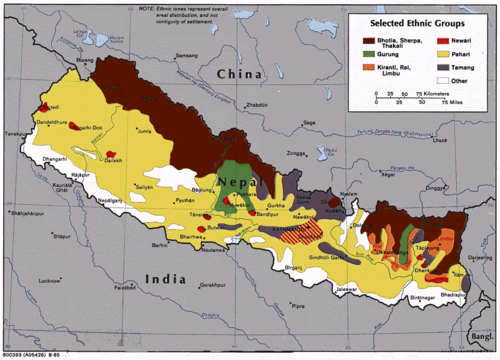
- Ethnic group: Kiratis
- Proposed state: Kirat
- Political party: Kirat Janabadi Workers Party
- Proposed state: Kirat
- Ethnic group: Madhesi peoples (including Maithils, Bhojpuris and Tharus).
- Proposed state: Madhesh
- Advocacy group: Alliance for Independent Madhesh[72]
- Militant Group: Janatantrik Terai Mukti Morcha, Madhesh Mukti Tigers (MMT), Tharuwan National Liberation Front (TNLF).[73]
- Proposed state: Madhesh
- Ethnic group: Teraibasi
- Proposed state: Terai
- Political party: Terai Army
- Proposed state: Terai
Pakistan
.svg.png.webp)
_(claims_hatched).svg.png.webp)

- Ethnic group: Western Kashmiri
- Proposed Autonomous state under Islamic Republic of Pakistan:
 Azad Kashmir[74]
Azad Kashmir[74] - Advocacy group: Kashmiri sovereignty movement, Azad Kashmiri Government
![]() Balochistan
Balochistan
- Ethnic group: Baloch
- Proposed state: Balochistan
 along with Sistan and Baluchestan of Iran and some parts of Afghanistan.[75]
along with Sistan and Baluchestan of Iran and some parts of Afghanistan.[75] - Political party: Baloch National Movement, Baloch Republican Party, Free Balochistan Movement (member of the Unrepresented Nations and Peoples Organization)
- Militant organisations: Baloch Liberation Army, Baloch Liberation Front, Baloch Republican Army
- Proposed state: Balochistan
- Ethnic group: Sindhi
- Proposed state: Sindhudesh

- Political parties: Jeay Sindh Qaumi Mahaz, Jeay Sindh Muttahida Mahaz, Sindh United Party
- Student organization: Jeay Sindh Students' Federation
- Proposed state: Sindhudesh
Philippines
- Ethnic group: Moro
- Militant organization: Abu Sayyaf,[78][79][80] Bangsamoro Islamic Freedom Fighters,[80][81][82] Khalifa Islamiyah Mindanao, Maute Group
- Advocacy group:Bangsamoro Islamic Freedom Movement[82]
Cordillera Administrative Region
- Ethnic group: Igorot
- Proposed autonomous area: Cordillera Autonomous Region[83] or Autonomous Region of the Cordillera[84]
- Advocacy group: Autonomy in the Administrative Cordillera Movement,[85] Cordillera People's Liberation Army,[86] Cordillera Bodong Administration[87]
- Proposed autonomous area: Metro Manila Autonomous Region[88]
Russia
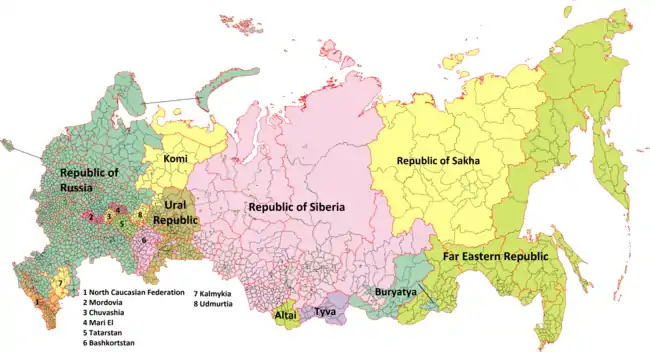
Summary
This table shows only the list of movements. The source of each movement is cited in its own section. The population of each area is provided for information only.

Autonomist movements
- Ethnic group: Koryaks
- Proposed federal subject:
 Koryak Autonomous Okrug
Koryak Autonomous Okrug
- Proposed federal subject:
![]() Taymyrsky Dolgano-Nenetsky District[91][92]
Taymyrsky Dolgano-Nenetsky District[91][92]
- Ethnic groups: Dolgans, Nganasan, Nenets, Russians
- Proposed federal subject:
 Taymyr Autonomous Okrug
Taymyr Autonomous Okrug
- Proposed federal subject:
Asian Russia
![]() Siberia or Siberian Federal District[93][94]
Siberia or Siberian Federal District[93][94]
- Ethnic group: Russians, Sibiryak (Siberian peoples)
- Proposed state:
 Siberian Republic
Siberian Republic - Advocacy movements: Siberskoye Zemlyachestvo (Autonomy Movement), Sibir, Free Siberia, Democratic Siberia, Association Tverd
- Movement: Siberian regionalism
- Political parties: Monstration for Siberian Federalization, All-Siberian Democratic Union, Siberian Republican Alliance, Roar of the Taiga (Zov Taugi), Tvyordynian Party
- Organizations: Siberian Agreement, Siberian Regional Organization (Siberskoye Zemlyachestvo), Tvyord
- Militant organizations: Siberian Liberation Army, New Siberian Army
- Proposed state:
Far Eastern Federal District
- Ethnic groups: Russians, Udeges, Nanais and other various ethnic groups
- Proposed state:
- Socialist:
 Far Eastern Republic
Far Eastern Republic - Federalist/Democratic:
 Far Eastern Republic
Far Eastern Republic
- Socialist:
- Proposed entity: Far Eastern Republic, including all territories from the Far Eastern Republic and/or modern-day federal subjects associated within the former lands of the aforementioned Far Eastern Republic (Note: This includes the modern-day federal subjects such as: Primorsky Krai, Khabarovsk Krai, Jewish Autonomous Oblast, Amur Oblast, Zabaykalsky Krai and Buryatia, sometimes federal subjects such as: Magadan Oblast, Kamchatka Krai and Chukotka Autonomous Okrug and Green Ukraine are included based on maximum extent from 1920. It may rarely or sometimes include all federal subjects in Far Eastern economic region and/or Far Eastern Federal District.)
- Advocacy movements: Far East Forum, Zemyak, Regional Association of the Far East
- Movements: Republican Movement, Far East Independence Movement
- Political party: Alliance of the Pacific Peoples
- Militant organization: Far Eastern People's Front
- Proposed state:
- Ethnic group: Yakuts
- Proposed state:
 Sakha Republic
Sakha Republic - Political party: Sakha-Amuk
- Proposed state:
- Ethnic group: Buryats
- Proposed state:
 Buryatia
Buryatia - Political party:All-Buryat Association for the Development of Culture
- Proposed state:
- Ethnic group: Nanai
- Proposed state:
.png.webp) Nanaia
Nanaia
- Advocacy group: Nanai Cultural Assembly
- Political party: Nanai People's Platform
- Proposed state:
- Ethnic group: Japanese People, Sakhalin Koreans, Ainu people
- Proposed state:
 Sakhalin, or Unification with
Sakhalin, or Unification with  Japan
Japan
- See also: Kuril Islands dispute
- Proposed state:
Siberian Federal District


- Ethnic group: Buryats
- Proposed state:
 Agin-Buryat Autonomous Okrug or unification with
Agin-Buryat Autonomous Okrug or unification with  Buryatia
Buryatia
- Proposed state:
- Ethnic group: Altai people
- Proposed state:
 Confederated Republic of Altai
Confederated Republic of Altai - Movement: Altai-Sayun United Movement
- Organizations: Altai Turks Associstion, Kurualtai of the Altai People
- Political parties: Confederal Nation of the Altai Tribes, Ene-Bayat
- Proposed state:
- Ethnic group: Evenks
- Proposed state:
 Evenkia[96]
Evenkia[96]
- Advocacy group: Evenki Homeland
- Militant organization: Evenki National Front
- Organization: Evenki Cultural Council
- Proposed state:
- Ethnic group: Khakas
- Proposed state:
 Khakassia
Khakassia
- Advocacy group: Khakas Cultural Centre
- Pressure group: Chas Khanat, Khaidzhi, Hongorai
- Organization: Abakan Tun Association of The Khakas, Congress of The Khakas People, Khakas Council of Elders
- Proposed state:
- Ethnic group: Tuvans
- Proposed state:

.svg.png.webp) Tuva
Tuva
- Political parties: People's Party of Sovereign Tuva, People's Front "Free Tuva", Tiva Turu
![]() Ust-Orda Buryat Autonomous Okrug
Ust-Orda Buryat Autonomous Okrug
- Ethnic group: Buryats
- Proposed state:
 Ust-Orda Buryat Autonomous Okrug or unification with
Ust-Orda Buryat Autonomous Okrug or unification with  Buryatia
Buryatia
Ural Federal District
![]() Khanty-Mansi Autonomous Okrug[97][98][99]
Khanty-Mansi Autonomous Okrug[97][98][99]
- Ethnic group: Khanty people and Mansi people
- Proposed state:
 Khanty-Mansi Autonomous Okrug
Khanty-Mansi Autonomous Okrug - Advocacy movements: Association to Save Yurga, Khanty Way, Mansi Way, Ob-Ugrian Union, Society for the Survival and Socio-Economic Development of the Mansi People, Ugrian Association, Youth Public Organization, Yurga Restoration
- Proposed state:
![]() Yamalia/Nenets Autonomous Okrug
Yamalia/Nenets Autonomous Okrug
- Ethnic group: Nenets
- Proposed state:
 Yamalia/East Nenetsia
Yamalia/East Nenetsia - Advocacy group: Yamal for Future Generations (Association of the Indigenous People of Yamal-Nenets Autonomus Region)
- Proposed state:
Saudi Arabia
Summary
| Number | Land | Capital | Area | Population | Ethnic | Main Political Party |
|---|---|---|---|---|---|---|
| 1 | Najran | Najran | 149,511 | 550,000 | Shia Arab | Ahrar al-Najran |
| 2 | Abha | 76,693 | 2,250,000 | Arabs | Asser Regional Movement (ARM) | |
| 3 | Ha'il | 103,887 | 600,000 | Arabs | Shammar Revival Movement | |
| 4 | Al-Hassa | Dammam | 672,522 | 5,000,000 | Shia Arab | |


In 2013 Robin Wright’s colorful map of a politically re-divided Middle East in the New York Times, which illustrated her article “Imagining a Remapped Middle East.” The map, entitled “How 5 Could Become 14,” shows a hypothetical future division of Libya, Iraq, Syria, Yemen, and Saudi Arabia into 14 potential new countries along with two additional city-states. I was immediately reminded of Ralph Peters’ troublesome remapping of the same region. As explained in a previous GeoCurrents post, Peters’ intriguing mental exercise in redrawing national boundaries was widely misinterpreted across the Muslim world as indicating a nefarious plot to enhance US power. As a result, the region’s pronounced anti-Americanism was further inflamed.[100][101][102][103]
Furthermore, in June 2012 the Yemeni newspaper Al-Shareh revealed the names of high-ranking Yemeni state officials and tribal sheikhs who had been receiving monthly bribes from Saudi Arabia. This sparked anger among Yemenis, and a group of Yemeni activists founded the "Asir Movement" in order to reclaim the provinces of Asir, Najran, and Jizan, which Yemen conceded in the 2000 Treaty of Jeddah. A "rights organization which has worked to denounce Saudi Arabia’s abuses in northern Yemen",[104] the Asir Movement described itself as a “civil popular” movement that seeks to raise "internal Yemeni awareness" about the situation and to explore legal remedies against Saudi Arabia "for their involvement and assistance in abdicating Yemen’s historical right to its territories", all while emphasizing Yemeni unity. The movement sought to speak out against the 2000 Jeddah border agreement as well as the 1934 Taif Agreement that was signed in 1934 to end the Saudi–Yemeni War.[105]
The Qatif conflict refers to the modern phase of sectarian tensions and violence in Eastern Arabia between Arab Shi'a Muslims and Arab Sunni majority, which has ruled Saudi Arabia since early 20th century. The conflict encompasses civil unrest which has been sporadically ongoing since 1979 events, pro-democracy and pro-human rights protests and occasional armed incidents, which increased in 2017 as part of the 2017–19 Qatif unrest.
Najran (Ahrar al-Najran movement is an alleged secessionist group in southern Saudi Arabia)
- Ethnic group: Shia Arab
- Proposed state: Najran
- Militant organizations: Ismaili Defense Group, Ahrar al-Najran, Najran Valleys Liberation Organization
- Organization: Najran Ismaili Association
- Political party: Disobedience (Tamarrod), Najran Now
- Proposed state: Najran
- Ethnic group: Arab
- Proposed state:
 Asir
Asir
- Advocacy groups: Abha Asir Highland Organization, Asser Regional Movement (ARM)
- Movement: Asir Movement, Idrisi Movement
- Militant organization: Democratic Popular Front for the Liberation of the Peninsula
- Organization: European Asir Organization
- Proposed state:
![]() Jabal Shammar (Ha'il Region)[107]
Jabal Shammar (Ha'il Region)[107]
- Ethnic group: Arab
- Proposed state:
 Jabal Shammar
Jabal Shammar
- Advocacy groups: Dhi Qar Shammar Tribal Union, Jabal Shammar Exile Association, Shamariyeh
- Militant organization: Al-Sanadid Forces
- Movements: Asir Movement, Idrisi Movement, Shammar Revival Movement, Qajtanite Movement
- Organization: Haiyel Shammar People's Organization
- Political party: Shammar Nation
- Proposed state:
Al-Hassa (Eastern Province, Saudi Arabia) (Qatif conflict)[108][109] including a series of protests and repression during the 2011–12 Saudi Arabian protests and 2017–2020 Qatif unrest.[110]
Sri Lanka
- Ethnic group: Tamil
- Proposed state:
 Tamil Eelam
Tamil Eelam - Militant organisation: Liberation Tigers of Tamil Eelam (Active, but militarily dormant since 2009)[111][112][113]
- Political party: Tamil National Alliance
- Advocacy groups: Transnational Government of Tamil Eelam
- Government in exile: Transnational Government of Tamil Eelam[114][115]
- Proposed state:
Syria
De facto autonomous region:
![]() Autonomous Administration of North and East Syria (Rojava)
Autonomous Administration of North and East Syria (Rojava)
- Larger ethnic groups: Kurds, Arabs, Assyrians
- Smaller ethnic groups: Armenians, Turkmen, Yazidis, Circassians
- Political organisation: Syrian Democratic Council
- Militant organisation: Syrian Democratic Forces
Taiwan
The ![]() Republic of China (ROC), commonly known as Taiwan, is a state that has diplomatic relations with 14 United Nations member states (as well as the Holy See, an observer).
Republic of China (ROC), commonly known as Taiwan, is a state that has diplomatic relations with 14 United Nations member states (as well as the Holy See, an observer).
- Proposed state:
 Republic of Taiwan
Republic of Taiwan
- Movement: Taiwan independence movement, Taiwanese nationalism
- Note: The Democratic Progressive Party (DPP) has been democratically elected to power in Taiwan four times; in 2000 (until 2004), in 2004 (until 2008), in 2016 (until 2020), and in 2020 (until 2024). Although the DPP has been the nominal ruling party of the Republic of China throughout these four ruling terms, the DPP has been pushing a pro-Taiwan independence agenda, whether tacitly or overtly. Some representatives of the DPP, such as William Lai, argue that Taiwan independence should not even be considered an "independence movement" but is rather the recognition of the reality of the current situation of the Republic of China on Taiwan. Many supporters of Taiwan independence believe that Taiwan, under the formal name of the "Republic of China", is already an independent country from mainland China, under the formal name of the "People's Republic of China".
- Political parties: Pan-Green Coalition (Democratic Progressive Party, Taiwan Solidarity Union, Taiwan Independence Party), New Power Party, Taiwan Statebuilding Party
- Advocacy groups: Keep Taiwan Free (Taiwanese organisation), World United Formosans for Independence
- Claimed territories: Taiwan (Kaohsiung, New Taipei, Taichung, Tainan, Taipei, Taiwan-Penghu, Taoyuan)
- Area of claimed territories: Roughly 36,000 km2
- Population of claimed territories: Roughly 24,000,000 people
- Movement: Taiwan independence movement, Taiwanese nationalism
- Proposed state:
Thailand
- Ethnic group: Pattani Malays
- Proposed state:
 Pattani Darul Makrif,[116] unification with
Pattani Darul Makrif,[116] unification with  Malaysia[117]
Malaysia[117] - Militant organisation: Patani United Liberation Organisation, Patani Malays National Revolutionary Front, Runda Kumpulan Kecil, Pattani Islamic Mujahideen Movement, Islamic Liberation Front of Patani
- Proposed state:
Turkey

- Ethnic group: Kurdish
- Proposed state:
 Kurdistan
Kurdistan - Militant organisations: Kurdistan Workers Party (PKK), Group of Communities in Kurdistan (KCK), Kurdistan Freedom Hawks (TAK), Democrat Party of Kurdistan/North (PDK/Bakur), Revolutionary Party of Kurdistan (PŞK), Communist Party of Kurdistan (KKP)
- Proposed state:
- Ethnic group: Assyrian
- Proposed state:
 Assyrian Democratic Republic
Assyrian Democratic Republic - Political parties: Assyrian Democratic Movement, Assyria Liberation Party
- Militant organisations: Nineveh Plain Protection Units, Dwekh Nawsha
- Advocacy groups: Assyrian General Conference, Assyria Council of Europe
- Proposed state:
Uzbekistan
- Ethnic group: Karakalpaks
- Proposed state:
 Republic of Karakalpakstan
Republic of Karakalpakstan - Advocacy group: Free Karakalpakstan National Revival Party[119]
- Proposed state:
Vietnam
![]() Khmers Kampuchea-Krom Federation
Khmers Kampuchea-Krom Federation
- Ethnic group: Khmer people
- Ethnic group: Indigenous peoples of the Central Highlands in Vietnam
Yemen



 South Yemen
South Yemen
- Proposed state:
 South Arabia,[120]
South Arabia,[120]  State of Aden
State of Aden - De facto state: Southern Transitional Council[121][122][123]
- Political party: South Yemen Movement
- Proposed state:
 Hadhramaut [124]
Hadhramaut [124]- Ethnic group: Arab
- Proposed state:
 Kathiri,
Kathiri,  Qu'aiti,
Qu'aiti,  Wahidi Balhaf,
Wahidi Balhaf,  Mahra[125][126][127]
Mahra[125][126][127] - De facto state: Hadhramaut Region, Protectorate of South Arabia
- Political party:
 Hadhrami League
Hadhrami League
- Political party:
- Proposed state:
See also
References
- Gehring, Kai; Schneider, Stephan A. (2017). "Regional Resources and Democratic Secessionism". Proceedings. Annual Conference on Taxation and Minutes of the Annual Meeting of the National Tax Association. 110: 6. ISSN 1549-7542. JSTOR 26794426.
- https://jam-news.net/russia-extradites-talysh-activist-to-baku/
- https://www.eurasiareview.com/06042016-talysh-movement-resurfaces-in-azerbaijan-oped/
- https://thediplomat.com/2017/07/12-regions-of-china-the-sichuan-basin/
- https://www.sandiegouniontribune.com/sdut-china-says-separatists-sparked-violence-in-sichuan-2012jan31-story.html
- Sautman, Barry (2005). "China's Strategic Vulnerability to Minority Separatism in Tibet". Asian Affairs. 32 (2): 87–118. doi:10.3200/AAFS.32.2.87-118. JSTOR 30172870. S2CID 154271958.
- Feuerwerker, Albert (1975). Rebellion in Nineteenth-Century China. Ann Arbor: University of Michigan. p. 60.
- Basic Law of the Hong Kong Special Administrative Region of the People's Republic of China, Article 5
- "Why Macau is obedient to China, and Hong Kong just the opposite". South China Morning Post. 11 January 2020. Retrieved 14 December 2020.
- "Why prosperous Macau does not follow Hong Kong's gamble for independence". The Perspective. 10 November 2016. Retrieved 14 December 2020.
- "How has Macau reacted to the Hong Kong pro-democracy protests?". www.abc.net.au. 24 August 2019. Retrieved 14 December 2020.
- "Kiribati cuts ties with Taiwan to switch to China, days after Solomon Islands". www.abc.net.au. 20 September 2019. Retrieved 14 December 2020.
- Hui, Mary. "Cantonese is Hong Kong protesters' power tool of satire and identity". Quartz. Retrieved 14 December 2020.
- Lau, Jessie. "Hong Kong's Minorities Face Racism From Police and Protesters". Foreign Policy. Retrieved 14 December 2020.
- "Explainer: From 'five demands' to 'independence' - the evolution of Hong Kong's protest slogans". Hong Kong Free Press HKFP. 25 June 2020. Retrieved 14 December 2020.
- Reuters Staff (31 July 2020). "Hong Kong leader says key election postponed, blow to pro-democracy camp". Reuters. Retrieved 14 December 2020.
- "What next for Hong Kong's pro-democracy movement? | NHK WORLD-JAPAN News". NHK WORLD. Retrieved 14 December 2020.
- Wilfred Chan, CNN, and Elaine Yu, for. "Is Hong Kong's fight for democracy in its final round?". CNN. Retrieved 14 December 2020.CS1 maint: multiple names: authors list (link)
- "Is universal suffrage as out of reach as ever for Hong Kong?". South China Morning Post. 26 September 2019. Retrieved 14 December 2020.
- Creery, Jennifer (9 June 2019). "Over a million attend Hong Kong demo against controversial extradition law, organisers say". Hong Kong Free Press HKFP. Retrieved 14 December 2020.
- "'Impossible to allow' discussions on Hong Kong independence in schools". South China Morning Post. 2 December 2020. Retrieved 14 December 2020.
- "UNPO: Southern Mongolia". unpo.org. Retrieved 14 December 2020.
- Jacobs, Andrew (13 December 2010). "Ethnic Mongolian Dissident Released by China Is Missing (Published 2010)". The New York Times. ISSN 0362-4331. Retrieved 14 December 2020.
- Steger, Isabella. "China's insatiable appetite for control is forcing even its "model minority" to rebel". Quartz. Retrieved 14 December 2020.
- "China's police minister talks terrorism during Inner Mongolia tour amid rare protests over language". Hindustan Times. 3 September 2020. Retrieved 14 December 2020.
- "内蒙古首例宣扬恐怖主义、 非法持有宣扬恐怖主义物品案宣判". www.ce.cn. Retrieved 14 December 2020.
- "Chinese Activists Set up Party That Wants Independence — For Shanghai". Radio Free Asia. Retrieved 14 December 2020.
- "上海民族党"在美国成立". SBS Your Language (in Chinese). Retrieved 14 December 2020.
- "Tibet part of China: Dalai Lama". The Age. 15 March 2005. Retrieved 15 December 2020.
- Rhodes, N.G. (1990). "The First Coins Struck in Tibet". The Tibet Journal. 15 (4): 115–134. ISSN 0970-5368. JSTOR 43300377.
- McGranahan, Carole (2003). "From Simla to Rongbatsa: The British and the "Modern" Boundaries of Tibet". The Tibet Journal. 28 (4): 39–60. ISSN 0970-5368. JSTOR 43302541.
- Sautman, Barry (2014). "Secessonism as a United States Foreign Policy Lever: Tibet in Context". The Brown Journal of World Affairs. 20 (2): 179–201. ISSN 1080-0786. JSTOR 24590981.
- Cowan, Sam (17 January 2016). "The curious case of the Mustang incident". The Record. Retrieved 15 December 2020.
- Jianping, Wang (2015), Deeg, Max; Scheid, Bernhard (eds.), "Unity in Diversity: The Islamic Revival Movement in China Today", Religion in China, Major Concepts and Minority Positions (1 ed.), Austrian Academy of Sciences Press, pp. 143–186, ISBN 978-3-7001-7759-3, JSTOR j.ctt1vw0pdc.13, retrieved 15 December 2020
- "Turkistan Islamic Party in Syria shows more 'little jihadists' | FDD's Long War Journal". www.longwarjournal.org. Retrieved 15 December 2020.
- "THE UIGHURS: A HISTORY OF PERSECUTION". govinfo. US Government Printing Office. 10 June 2009. Retrieved 15 December 2020.
- "Uyghurs call for 2022 Beijing Winter Games to be relocated". www.abc.net.au. 14 August 2020. Retrieved 15 December 2020.
- "Full text: The Fight Against Terrorism and Extremism and Human Rights Protection in Xinjiang". People's Daily. March 2019. Retrieved 15 December 2020.
- "China could face greater terrorism threat after US 'delists' ETIM". South China Morning Post. 7 November 2020. Retrieved 15 December 2020.
- "Consolidated TEXT: 32002R0881 — EN — 10.10.2015". eur-lex.europa.eu. Retrieved 15 December 2020.
- Reuters Staff (20 July 2016). "Britain adds Chinese militant group to terror list". Reuters. Retrieved 15 December 2020.
- "Governance Asia-Pacific Watch". UNPAN. April 2007. Archived from the original on 29 August 2007. Retrieved 15 December 2020.
- "Russia's Javakhk Diaspora demands autonomous region status for Samtskhe-Javakhk". Times.am. Retrieved 28 February 2010.
- "US State Department and Javakhk: The WikiLeaks Cables Part I". Asbarez. 9 September 2011. Archived from the original on 11 October 2012. Retrieved 9 September 2011.
- Ghosal, Aniruddha (17 April 2019). "Former Militants of Banned Outfit Among Those on Election Duty in Darjeeling". News18. Retrieved 15 October 2019.
The organisation, banned by the Union government in 2014, aims to carve out a separate Kamtapur nation from India, comprising of six districts in West Bengal and four in Assam
- BASUMATARY, RINOY. "KLO vows to launch armed liberation struggle against 'India'". NORTHEAST NOW. Retrieved 15 October 2019.
That imperialist India is the main enemy of our national struggle. Independent Kamatapur shall comprise the entire Kamatapur in India.
- Selvaraj6, A. "Suspected member of Kamtapur militant group arrested in Chennai | Chennai News - Times of India". The Times of India. Retrieved 15 October 2019.
The Chennai city police on Friday arrested a suspected member of an extremist organization that demands carving out a separate state - Kamtapur - from West Bengal and Assam.
- "Tahun 2015 Indonesia 'Pecah', Ini Petanya".
- "Gerakan Bali Merdeka". www.facebook.com.
- "LMMT, SOLUSI POLITIK UNTUK PEMEKARAN PROPINSI TAPANULI".
- "Minahasa Nationalism". Indonesia Matters. Retrieved 23 October 2014.
- "Christian Sulawesi (Minahasa) seeks independence from Muslim Indonesia". Archived from the original on 18 February 2015. Retrieved 23 October 2014.
- Basista, Ronny. "Tabrani Rab dan Gerakan Riau Merdeka". —. Archived from the original on 17 February 2017. Retrieved 13 December 2017.
- "Archived copy". Archived from the original on 12 August 2010. Retrieved 28 July 2010.CS1 maint: archived copy as title (link) National Libration [sic] Movement of Ahwaz
- "Democratic Party of Iranian Kurdistan". Democratic Party of Iranian Kurdistan. Archived from the original on 1 April 2009. Retrieved 11 April 2009.
- Donahue, Chris. "FULFORD: An Independent Movement Has Started in Japan's Northern Island of Hokkaido >> Four Winds 10 – Truth Winds". fourwinds10.net. Archived from the original on 2 May 2014. Retrieved 12 May 2013.
- Legendre, Joel (7 February 2010). "Asian Gazette Blog ✍ Joël Legendre-Koizumi: Ainu claim independence to Prime Minister Hatoyama". Archived from the original on 2 May 2014. Retrieved 12 May 2013.
- Fackler, Martin (5 July 2013). "In Okinawa, Talk of Break From Japan Turns Serious". The New York Times.
- "Bukan TMJ atau PM tentukan Johor keluar Malaysia" (in Malay). malaysiakini.com. 5 June 2016.
- "KELANTAN KELUAR MALAYSIA ?".
- "Group draws up self determination petition for Sarawak and Sabah". Borneo Post. 13 August 2014. Archived from the original on 12 November 2014. Retrieved 12 November 2014.
- "Many in Sabah, Sarawak don't want to be part of Malaysia, claims analyst". The Rakyat Post. 16 February 2014. Archived from the original on 4 March 2016. Retrieved 12 November 2014.
- "Independence referendum for Sarawak focal point of STAR agenda in state election, says Soo". Borneo Post Online. 7 December 2019.
- "Malaysia an illegal union, claims Sarawak opposition leader". 21 November 2019.
- "Sabahan secession instigator unfazed by impending probe". The Star. 6 September 2014. Archived from the original on 11 November 2014. Retrieved 12 November 2014.
- "Merger of Sabah, S'wak and Brunei | Daily Express Online - Sabah's Leading News Portal". www.dailyexpress.com.my.
- Myint, Moe (24 October 2017). "Rakhine Crisis in Numbers". The Irrawaddy. Archived from the original on 27 October 2017. Retrieved 27 October 2017.
- "Who we are?". www.rohingya.org. Arakan Rohingya National Org. Archived from the original on 16 January 2019. Retrieved 22 February 2020.
- "Press Release: Arakan Independence Alliance". Archived from the original on 21 December 2018. Retrieved 22 February 2020.
- "Press release : Facts about Arakan Rohingya National Organisation". www.rohingya.org. 24 October 2007. Archived from the original on 30 May 2016. Retrieved 14 May 2016.
- "The Transnational Government of Tamil Eelam". tgte-us.org. Archived from the original on 21 September 2012. Retrieved 20 September 2012.
- "Madhesis in Nepal to continue protests till next election, says separatist leader". Catch News. 3 February 2016. Archived from the original on 6 March 2016. Retrieved 1 March 2016.
- "Nepal Terrorist Groups – Madheshi Armed Outfits". satp.org. Archived from the original on 15 September 2017. Retrieved 30 September 2017.
- Abi-Habib, Maria; Mughal, Jalaluddin; Masood, Salman (19 September 2019). "In Pakistan-Held Kashmir, Growing Calls for Independence". The New York Times.
- Malik Siraj Akbar (30 March 2011). The Redefined Dimensions of Baloch Nationalist Movement. Xlibris Corporation. p. 29.
The ultimate goal of BLA is “Greater Balochistan”, a country that will comprise the Baloch areas of Pakistani and Iranian Balochistan provinces and some parts of Afghanistan.
- Bansal, Alok. "Violent Sindhi nationalism raises its head again". South Asia Monitor. Archived from the original on 23 November 2015. Retrieved 23 November 2015.
- "Now Sindhis Demand Independent Nation In Pakistan". Outlook. Retrieved 15 November 2019.
- Pike, John. "Abu Sayyaf Group (ASG)". FAS Intelligence Resource Program. Archived from the original on 4 May 2006. Retrieved 20 February 2015.
- Chido, Diane. "Intel Brief: The Abu Sayyaf model". International Relations and Security Network. International Relations and Security Network. Archived from the original on 29 November 2014. Retrieved 20 February 2015.
- "BIFF, Abu Sayyaf pledge allegiance to Islamic State jihadists". GMA News. Agence France-Presse. 16 August 2014. Archived from the original on 28 January 2015. Retrieved 20 February 2015.
- "Archived copy". Archived from the original on 24 September 2015. Retrieved 29 June 2015.CS1 maint: archived copy as title (link)
- Sabillo, Kristine Angeli (20 February 2015). "BIFF only wants Islamic state". Philippine Daily Inquirer. Archived from the original on 20 February 2015. Retrieved 20 February 2015.
- "Cordillera Solons expressed views on regional autonomy". National Economic and Development Authority – Cordillera Administrative Region. 12 August 2013. Archived from the original on 2 April 2015. Retrieved 28 February 2015.
- Ponciano, Mark Allen (24 March 2017). "Cordi autonomy bill filed as HB 5343". National Economic and Development Authority – Cordillera Administrative Region. Archived from the original on 19 July 2018. Retrieved 6 October 2017.
- Dumlao, Artemio (11 February 2014). "Autonomy movement revived in Cordillera". The Philippine Star. Archived from the original on 31 August 2017. Retrieved 31 August 2017.
- Dumlao, Artemio (31 January 2013). "Rebels still dream of Cordillera's autonomy". The Philippine Star. Archived from the original on 3 October 2017. Retrieved 3 October 2017.
- Bitog, Rubyloida (21 April 2013). "Elders unite Bodong factions". Sun Star Baguio. Archived from the original on 6 October 2017. Retrieved 6 October 2017.
- "QC mayor Bautista seeks 'independent Metro Manila state'". Rappler. 17 August 2017. Archived from the original on 31 August 2017. Retrieved 31 August 2017.
- ""Ready for decisive action" - Aboriginals threaten Koryakia to leave the region". Kam 24 (in Russian). 20 October 2020. Retrieved 11 November 2020.
- Latypova, Guzel (21 October 2020). "The Koryaks recalled their status". Kommersant (in Russian). Retrieved 11 November 2020.
- Korolkova, Elizabeth (7 December 2017). ""They keep their dead in the barn": why they cannot bury the dead in Taymyr". Open Russia (in Russian). Retrieved 2 October 2019.
- Starinova, Julia (26 July 2017). "Taymyr residents again demand a referendum on autonomy". Radio Liberty (in Russian). Retrieved 2 October 2019.
- "Перспективы сибирского шамана". Region Expert (in Russian). 16 December 2019. Retrieved 9 January 2020.
- "Секретный арест за "сепаратизм"". Region Expert (in Russian). 19 January 2020. Retrieved 9 January 2020.
- Vorozhko, Tatiana (21 March 2014). "Buryatia has already started talking about independence from Russia". Voice of America (in Ukrainian). Retrieved 31 October 2019.
- Minahan, James (30 May 2002). Encyclopedia of the Stateless Nations: Ethnic and National Groups Around the World A-Z [4 Volumes]. ISBN 9780313076961.
- Libman, Alexander; Rochlitz, Michael (2019). Federalism in China and Russia. ISBN 9781788972192.
- York), Eastwest Institute (New (2000). The Republics and Regions of the Russian Federation: A Guide to Politics, Policies, and Leaders. ISBN 9780765605597. Missing
|author1=(help) - Giuliano, Elise (15 March 2011). Constructing Grievance: Ethnic Nationalism in Russia's Republics. ISBN 9780801460722.
- "Robin Wright's Audacious Remapping of the Middle East".
- Whitaker, Brian (26 March 2015). "From one Yemen to a dissolution of Saudi Arabia".
- http://geocurrents.info/wp-content/uploads/2013/10/Robin-Wrights-Remapped-Middle-East.png
- http://geocurrents.info/wp-content/uploads/2013/10/Saudi-Arabia-Remapped-by-Robin-Wright.png
- "Yemen's Houthis standing ground against Saudi Arabia". Press TV. 7 February 2014.
- Jomana Farhat (15 June 2012). "Saudi-Yemeni Border: A Line in the Sand". Al Akhbar.
- Abir, Mordechai (19 December 2013). Saudi Arabia: Society, Government and the Gulf Crisis. ISBN 9781317799344.
- https://css.ethz.ch/content/dam/ethz/special-interest/gess/cis/center-for-securities-studies/resources/docs/ISPSW_506_Bodansky.pdf
- "Awamiya: Inside Saudi Shia town devastated by demolitions and fighting". BBC News. 16 August 2017. Archived from the original on 25 February 2018. Retrieved 6 October 2017.
- "Rebels admit defeat in Sri Lankan civil war | detnews.com | The Detroit News". detnews.com. Retrieved 30 May 2009.
- "Two Malaysian DAP assemblymen, 8 others charged over alleged links to Liberation Tigers of Tamil Eelam". The Straits Times. 29 October 2019.
- "Twelve allegedly linked to LTTE to be charged in court". The Star. 28 October 2019.
- "STATEMENT ON DECLARATION OF SHAN STATE INDEPENDENCE Boxun News". peacehall.com. Archived from the original on 4 June 2012. Retrieved 20 September 2012.
- "Sri Lankan Tamil Struggle – Chapter 18: The First Sinhalese- Tamil Rift". T. Sabaratnam. Ilankai Tamil Sangam. Retrieved 19 January 2012.
- "Pattani United Liberation Organization (PULO)". GlobalSecurity.org. Archived from the original on 10 March 2009. Retrieved 10 April 2009.
- "Bendera Malaysia dinaikkan di selatan Thai". cari.com.my (in Malay). 1 September 2012.
- Pike, John (21 May 2004). "Kurdistan Workers' Party (PKK)". Federation of American Scientists. Archived from the original on 28 April 2008. Retrieved 23 July 2008.
- "Uzbekistan: Shadowy Group Agitates For 'Free Karakalpakstan'". Radio Free Europe/Radio Liberty. 5 April 2008. Archived from the original on 17 February 2009. Retrieved 11 April 2009.
- "Five killed at secessionist protest in south Yemen". London: BBC. 25 November 2009. Retrieved 25 November 2009.
- The New Arab. "GCC: Aden-based Southern Transitional Council 'doomed to fail'". alaraby.co.uk. Archived from the original on 29 July 2017. Retrieved 8 June 2017.
- The New Arab. "Banished Aden governor forms independent 'South Yemen' council". alaraby.co.uk. Archived from the original on 11 May 2017. Retrieved 8 June 2017.
- Saudi Research & Marketing (uk) Ltd. "Thirty Southern Figures Reject Transitional Council in Aden – ASHARQ AL-AWSAT English". Asharq Al-Awsat. Archived from the original on 17 May 2017. Retrieved 8 June 2017.
- https://jamestown.org/program/the-growing-separatist-threat-in-yemens-hadramawt-governorate/
- "Yemen's Beleaguered Al Mahrah Seeks Autonomy". Archived from the original on 14 July 2015. Retrieved 14 July 2015.
- "Revolution in Socotra – Middle East Research and Information Project". merip.org. 26 May 2012. Archived from the original on 12 February 2015. Retrieved 12 February 2015.
- "Yemen Times [ Offline ]". yementimes.com. Archived from the original on 12 February 2015. Retrieved 12 February 2015.
_(%252Ball_claims_hatched).svg.png.webp)
_(%252Ball_claims_hatched).svg.png.webp)
.svg.png.webp)
_(%252Ball_claims_hatched).svg.png.webp)
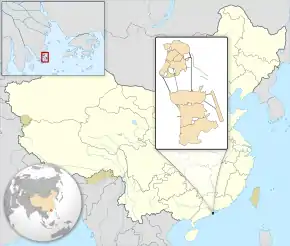

.svg.png.webp)




.svg.png.webp)



.svg.png.webp)
_(Crimea_disputed).svg.png.webp)
.svg.png.webp)
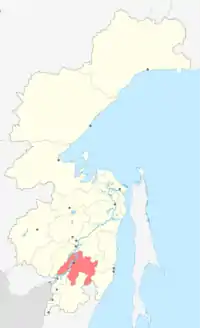
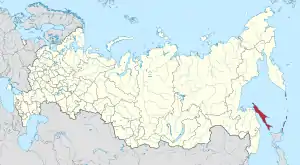



.svg.png.webp)











